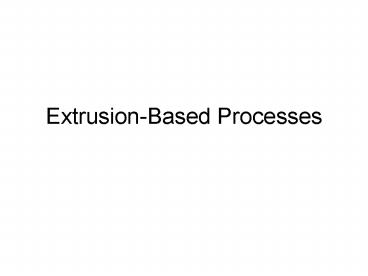Extrusion-Based Processes - PowerPoint PPT Presentation
1 / 17
Title:
Extrusion-Based Processes
Description:
Title: Slide 1 Author: Mariatti Jaafar Last modified by: Dr Mariatti Created Date: 7/29/2006 12:41:09 PM Document presentation format: On-screen Show – PowerPoint PPT presentation
Number of Views:342
Avg rating:3.0/5.0
Title: Extrusion-Based Processes
1
Extrusion-Based Processes
2
Profile Extrusion
- Solid parts that have shapes other than simple
round rods of flat sheets are called profile
shapes/profiles - Is a direct manufacture of product from the
extruder die - These products are continuous lengths, the
cross-sectional profile is determined by the die
shape - Examples PE gas piping, PVC water and drainage
pipes, garden hose, etc
3
Profiles and Die
- Design of dies- difficult process
- Example in producing pipe, mandrel is used to an
annulus through which the pipe will emerge. Screw
adjuster need to be used to centralized the
mandrel - The presence of screw will interrupt the melt flow
Schematic diagram of pipe die
4
Profiles and Die
- Shape of the exit orifice might be slightly
different the shape of the final part - This is due to the tendency of molten plastics to
flow more in the larger parts of the die (i.e. at
the center), swell as it exits the die, shrink
when it cooled - Die swell ( the swelling process) distorts the
shape of the extrudate - Therefore the shape of the die opening must
compensate the die swell and the distortion
phenomena
5
Profiles and Die
- If the die has a sharp corners, the flow will be
less in the location, and sharpness of the corner
will be round - If the sharp angle is desired in the final
product, the die should have a slight excess of
material in the region between the points of the
sharp angle
6
Downstream Operations
- Often extrusion of profiles requires downstream
(the addition of a secondary operation to deliver
a fully satisfactory product) - e.g.the die swell in an extruded pipe. The die
dimension is only an approximation - The drawdown is applied to pull the extrudate
away from the die exit, this counteracts the swell
7
Downstream Operations
- If exact internal diameter is required, internal
sizing size is used - The extruded pipe, while still hot and soft from
the extruder, is passed over a mandrel of
appropriate size
Pipe extrusion internal sizing mandrel
8
Downstream Operations
- If exact internal diameter is required, external
sizing device is required - Pipe is pressurized against internal mandrel by
an air injection - A vacuum outside the mandrel allows the normal
atmospheric pressure inside the pipe to hold it
against the mandrel
- Pipe extrusion external sizing
- Pressure sizing
- Vacuum sizing
9
Extrusion Based Processes1. Coating of Wire and
Cable
- The biggest sector of the industry is the
electrical cable manufacture - In this process, the flow of the resin is
directed to the side of the extruder through an
offset die (tube attached to the end of the
extruder with a right angle turn to move the
molten resin to the side of the extruder) - The offset channel then merges into the crosshead
die. - Fire hose is also produced by this technique
10
Orientation in Pipes and Hoses
- Orientation of chain occur in the machine
direction - Thus the properties of extruded product are
anisotropic
If an extruded pipe is tested by pressurizing it
until it burst, Where the failure will occur????
11
2. Blown Film
- The extruded materials flow through a tubular die
- The melt flow around a mandrel and exits the die
as a tube - A cooling ring is placed at the exit of the die
to give the tube some dimensional stability - Air is introduced through the back of the die and
flow upwards inside the middle of the tube of
materials
12
2. Blown Film
- The tube or bubble, continues to expand, cool and
crystallize until the radial (tensile) strength
of the plastics equals the pressure of the air
inside. - The bubble is then forced into a flat sheet by
the collapsing guides, and moved into the nips
rolls - Then it travels down over some rollers and it was
sealed
13
2. Blown Film
- The stretching and cooling of the tubes causes
the molecules to be oriented - Push of the internal air orients the molecules in
radial direction - Nip rolls orients the molecules in the machine
direction - Blown film are therefore are biaxially oriented
- The orientation causes some crystallization in
the film
14
2. Blown Film
- The amount of expansion of the bubble is
important in controlling the process predicting
mechanical properties - Parameter blow-up ratio (ratio of the final tube
diameter after blow-up to the diameter of the
orifice of the die) is important, ratio of 31 is
common - Most mechanical properties are increased as the
blow-up ratio increases because orientation
increases - Materials are amorphous when exit the die, as it
cools and stretches the molecules become more
oriented, then become less transparent
15
3. Calendering
- Alternate method for making sheets or flat film
- In this process, the extrudate is extruded
directly into the nip area between two rolls. - The roles have small gap between them, and
plastics is forced through this gaps by the
counterrotating of the rolls.
16
4. Co-Extrusion
- Extrusion of more than one type of polymer at
once to give a laminated product - This technique allows product to have different
properties on each side - Example, the inner containers of breakfast
cereals are mode from blown HDPE film with the
inner layer of lower softening temp.
17
Co-extrusion Die for Blown Film































